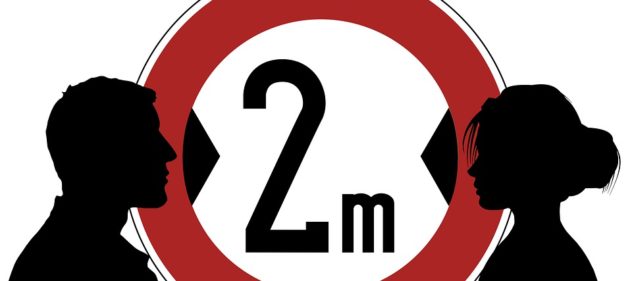Pre-Reading Questions:
- Do you wear face masks?
- Do you think scientists will find a cure for the coronavirus?
Vocabulary:
- distance /DIS-tuhns/
- another /uh-NUTH-er/
- spend /spend/
- possible /POS-uh-buhl/
- object /OB-jekt/
[noun] – the amount of space between two places or things
The distance from earth to the sun is about 150 million kilometers.
[determiner] – one more person or thing, or an extra amount
I’m going to get another piece of paper.
[verb] – to use time doing something or being somewhere
I spend two hours a day learning Spanish.
[adjective] – that might or might not happen
If possible, please email us before 12 o’clock.
[noun] – a thing that can be seen, held, or touched, usually not a living thing
A strange object can be seen from the sky.
Research says that the closer you are to a person with the coronavirus, the bigger the chance of you getting it. The World Health Organization (WHO) recommends to keep a one-meter distance away from people but others suggest to go for 1.5 to 2 meters. Distance is one important thing to think about but another thing to note is the time you spend in close distance with people outside. The UK government suggests to limit the time spent in direct contact with people if possible.
The two-meter rule of social distance came from a research in the 1930s. It says that if somebody coughs or sneezes, small droplets released in the air will either evaporate or be pulled down by gravity. A large part of it will fall around two meters. Because of this, scientists list distance with an infected person and touching of infected objects as ways for a person to get the virus.
At present, we’re still not sure what “safe” distance is. Scientists are still finding answers to how viruses can be carried and if they are still harmful when they reach a certain distance. For now, wearing face masks and keeping a distance of at least two meters are some of the ways people can follow to stop viruses from spreading.
The two-meter rule of social distance came from a research in the 1930s. It says that if somebody coughs or sneezes, small droplets released in the air will either evaporate or be pulled down by gravity. A large part of it will fall around two meters. Because of this, scientists list distance with an infected person and touching of infected objects as ways for a person to get the virus.
At present, we’re still not sure what “safe” distance is. Scientists are still finding answers to how viruses can be carried and if they are still harmful when they reach a certain distance. For now, wearing face masks and keeping a distance of at least two meters are some of the ways people can follow to stop viruses from spreading.
True or False:
- Research says that the nearer you are to a person with the virus, the bigger the chance of you getting it.
- Right now, scientists are still not sure what the “safe” distance is.
- The two-meter rule of social distance came from a research in the 1950’s.
- The World Health Organization (WHO) recommends to keep two-meter distance away from people during the COVID19 pandemic.
- If somebody coughs or sneezes, small droplets released in the air will either evaporate or be pulled down by gravity.
Vocabulary Check:
Complete the sentences by using the words in the box.
| distance | spend | possible | another | object |
- Would you call me back in ten minutes if _______?
- She got ________ slice of pizza.
- Paul _______ twenty minutes waiting for his teammates.
- Birds like to collect shiny _______.
- The _______ from here to the nearest supermarket is about half a kilometer away.
